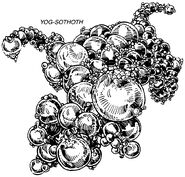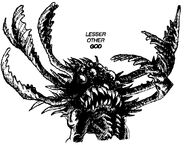- "The other gods! The other gods! The gods of the outer hells that guard the feeble gods of earth!"
- ―Barzai the Wise
The Outer Gods, a.k.a. the Other Gods from Outside or simply the Other Gods, are a species of primordial cosmic entities which move between and beyond dimensions, being often invisible and unreachable by Human senses. Chief among them is Azathoth, lord of all creation. Nyarlathotep, the crawling chaos, is their messenger. Although they can be found in both the Waking World and the Dreamlands, their ultimate dwelling place is the center of all infinity, referred to as "the central void".
The Outer Gods are gigantic, blind, voiceless, tenebrous and mindless. They are the ultimate gods, which dwarf in size and power the ordinary gods of Earth. Compared to them, the earthly gods are weak, and rely on the Outer Gods for protection. The Great Old Ones are the Outer God's progeny. The Elder Gods their age-old enemies.
The infamous occult tome known as the Necronomicon, by Abdul Alhazred, refers to this species as the Old Ones, which exist "not in the spaces we know, but between them", although it also claims that the Earth was once inhabited by them, and will be again in the future. It should be noted that, while the term "Old Ones" is more commonly associated with the Great Old Ones (among other things), the passage's mention of Yog-Sothoth and Shub-Niggurath and identification of Cthulhu as "Their cousin" (as opposed to one of them) clarifies that in this case it refers to the Outer Gods.
Biology[]
The Outer Gods typically look hideous and amorphous. Their sight alone tends to cause insanity or death. The most powerful among them have several avatars that they can use to interact with other species.
The Necronomicon describes them as invisible to man, shapeless and "undimensional", and claims that the only way to perceive their presence is by the peculiar smell that they emanate. In spite of that, they can somehow interbreed with Humans (possibly by manifesting as humanoid avatars) and their offspring range in form from completely Human-like to monstrously amorphous.

The Larvae of the Outer Gods drift through space.
In spite of their great power, the Outer Gods are blind and mindless creatures, "possessed of singular hungers and thirsts". Their larvae are black shapeless things with slimy paws that move through the aether of space, particularly in the Dreamlands. Still, entities such as Nyarlathotep (identified as the Outer Gods' soul and messenger) are capable of mimicking Human appearance and behaviour, enough to converse and interact with Humans.
The Court of Azathoth[]
At the center of infinity, "outside the ordered universe", beyond time, and beyond even the Dreamlands' reach, is the central void inhabited by Azathoth and his kin, the latter dancing to the sound of pipes and drums played by their servitors, while the daemon-sultan himself "gnaws hungrily in the dark".
Culture and society[]
- "At least twice in the world’s history the Other Gods set their seal upon earth’s primal granite; once in antediluvian times, as guessed from a drawing in those parts of the Pnakotic Manuscripts too ancient to be read, and once on Hatheg-Kla when Barzai the Wise tried to see earth’s gods dancing by moonlight"
- ―The Dream-Quest of Unknown Kadath
Like the Great Old Ones, the Outer Gods are venerated as deities by several species across the universe, such as the Gugs and Moon-Beasts.
The Outer Gods protect the lesser gods of Earth and the Dreamlands, known as the Great Ones, and will severely punish anyone that offends them.
In the Dreamlands, the Outer Gods have several mortal agents, Humans and otherwise, who do their bidding in return for the favour of Nyarlathotep.
List of Outer Gods[]
At the moment, 40 Outer Gods are known, but it is assumed that there may be more of them.
- Abhoth
- Aiueb Gnshal
- Azathoth
- Azhorra-Tha
- Blackness from the Stars
- Botsu
- C'thalpa
- Cloud Thing
- Cxaxukluth
- D'endrrah
- Daoloth
- Darkness
- Droom-avista
- Ghroth
- Gi-Hoveg
- Haiogh-Yai
- Huitloxopetl
- Hydra
- Ialdagorth
- Iod
- K'thun
- Kaajh'Kaalbh
- Kaalut
- Lilith
- Lu-Kthu
- Mh'ithrha
- Mlandoth
- Mril Thorion
- Mother of Pus
- Nameless Mist
- Ngyr-Korath
- Nhimbaloth
- Noth-Yidik
- Nyarlathotep
- Nyctelios
- Olkoth
- Ramasekva
- Shabbith-Ka
- Shub-Niggurath
- Star Mother
- Suc'Naath
- Taranushi
- Tru'nembra
- Tulzscha
- Ubbo-Sathla
- Uvhash
- Xa'ligha
- Xexanoth
- Ycnàgnnisssz
- Yhoundeh
- Yibb-Tstll
- Yidhra
- Yog-Sothoth
- Yomagn'tho
Appearances[]
- "Nyarlathotep", by H. P. Lovecraft (1920)
- "The Dunwich Horror", by H. P. Lovecraft (1929)
- "The Strange High House in the Mist", by H. P. Lovecraft (1931)
- "The Dreams in the Witch House", by H. P. Lovecraft (1933)
- "The Other Gods", by H. P. Lovecraft (1933)
- "The Haunter of the Dark", by H. P. Lovecraft (1936)
- The Dream-Quest of Unknown Kadath, by H.P. Lovecraft (1943)
Gallery[]
Notes[]
- This species has never been called Outer Gods in Lovecraft's fiction. Instead, they are called the Other Gods from Outside, or simply the Other Gods. In "The Dunwich Horror", the Necronomicon refers to them as the Old Ones.
- Although black holes hadn't been discovered yet in Lovecraft's time, the description of the dwelling place of the Outer Gods bears an uncanny resemblance to the supermassive black hole at the center of the galaxy, lightless and beyond time, as black holes distort time.
- The court of Azathoth is located at the center of the universe. However, at the time The Dream-Quest of Unknown Kadath was written (1927, although it was only published much later), the distinction between universe and galaxy (i.e. the idea that our galaxy is just one of many) was still in the process of being demonstrated by Edwin Hubble's studies, and wasn't yet common knowledge. Ergo, most writers at the time wouldn't make a distinction between the center of the galaxy and the center of "all infinity", where Azathoth and his kin dwell.






